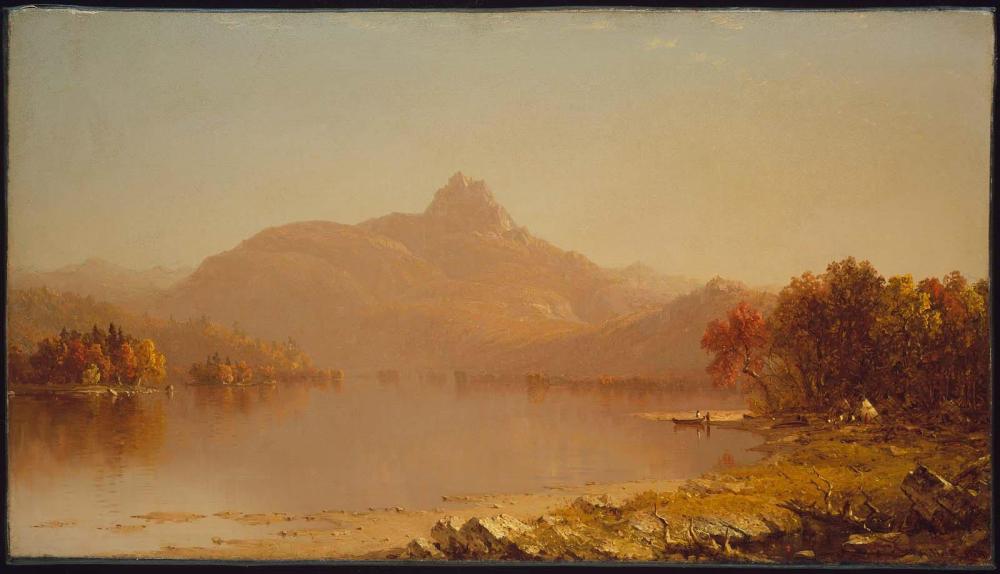Advanced Search 

An October Afternoon
Sanford Robinson Gifford (American, 1823–1880)
1871
Medium/Technique
Oil on canvas
Dimensions
34.29 x 60.96 cm (13 1/2 x 24 in.)
Credit Line
Henry H. and Zoe Oliver Sherman Fund
Accession Number1988.150
CollectionsAmericas
ClassificationsPaintings
Sanford Robinson Gifford’s An October Afternoon, which he produced after a remarkably productive period in his career, reflects the maturity of the landscape-painting tradition in the United States that stemmed from Thomas Cole [47.1201] and his followers. With the palpable orange glow of an Indian summer day Gifford creates a sense of time suspended in sublime light. The horizontal composition—a stretch of shore curving around a glistening body of water—also recalls seascapes by Heade [47.1143] and Kensett [48.440]. These qualities place Gifford’s painting within the style often called luminism, a term first used in 1947 to describe similarly light-infused American landscapes.
Gifford depicts the distinctive silhouette of Mount Chocorua in New Hampshire, where the artist sketched between 1863 and 1865. The site was closely associated with Indian legend as it takes its name from a Native American, in this case a historical figure, Chief Chocorua, who was shot on one of the high ledges by an early settler in the area. Along the shore at the left, Gifford depicts a cluster of figures, teepees, and canoes consistent with the folklore of the region. The warm illumination, calm reflections, and diminutive figures in relation to majestic scenery all convey the artist’s awe of the natural landscape in which Native Americans coexist in an idyllic state of perfect harmony.
Gifford’s scene of Native Americans peacefully inhabiting a wilderness unspoiled by white colonization was clearly nostalgic. The notion that Native Americans embodied the traditions of the noble savage had culminated at mid-century. In 1855 Henry Wadsworth Longfellow’s epic poem The Song of Hiawatha was at the height of popularity, and in 1856 American sculptor Thomas Crawford designed the statue of a seated chief for the Progress of American Civilization group on the east pediment of the United States Capitol. By 1871, when Gifford painted An October Afternoon, the Native American communities throughout the Northeast and even in much of the West had become a vision of the past.
This text was adapted from Elliot Bostwick Davis et al., American Painting [http://www.mfashop.com/9020398034.html], MFA Highlights (Boston: MFA Publications, 2003).
Gifford depicts the distinctive silhouette of Mount Chocorua in New Hampshire, where the artist sketched between 1863 and 1865. The site was closely associated with Indian legend as it takes its name from a Native American, in this case a historical figure, Chief Chocorua, who was shot on one of the high ledges by an early settler in the area. Along the shore at the left, Gifford depicts a cluster of figures, teepees, and canoes consistent with the folklore of the region. The warm illumination, calm reflections, and diminutive figures in relation to majestic scenery all convey the artist’s awe of the natural landscape in which Native Americans coexist in an idyllic state of perfect harmony.
Gifford’s scene of Native Americans peacefully inhabiting a wilderness unspoiled by white colonization was clearly nostalgic. The notion that Native Americans embodied the traditions of the noble savage had culminated at mid-century. In 1855 Henry Wadsworth Longfellow’s epic poem The Song of Hiawatha was at the height of popularity, and in 1856 American sculptor Thomas Crawford designed the statue of a seated chief for the Progress of American Civilization group on the east pediment of the United States Capitol. By 1871, when Gifford painted An October Afternoon, the Native American communities throughout the Northeast and even in much of the West had become a vision of the past.
This text was adapted from Elliot Bostwick Davis et al., American Painting [http://www.mfashop.com/9020398034.html], MFA Highlights (Boston: MFA Publications, 2003).
InscriptionsLower right: S R Gifford 1871
Provenance1871, the artist; 1881, Samuel J. Harriot (1834-1919), New York. 1964-5, Donald Broman; 1965, with Vose Galleries, Boston; 1965, sold by Vose Galleries to Frank E. Taplin, Princeton, N.J.; by 1987, with Gregory Shephard/Interart, Providence, R.I.; 1988, with Vose Galleries, Boston; 1988, sold by Vose Galleries to the MFA. (Accession Date: March 23, 1988)
